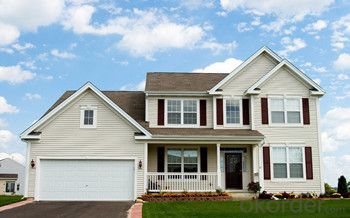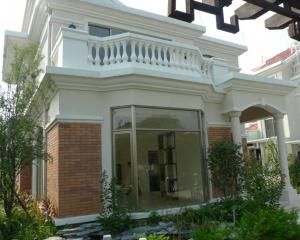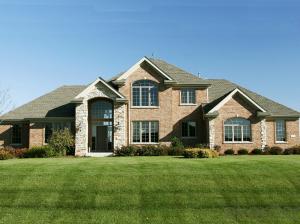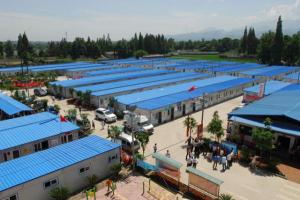Prefab Villa, Light Steel Structure with Cement Sandwich Panel
- Loading Port:
- Shanghai
- Payment Terms:
- TT OR LC
- Min Order Qty:
- 1 m²
- Supply Capability:
- 10000 m²/month
OKorder Service Pledge
OKorder Financial Service
You Might Also Like
prefab villa, light steel structure with cement sandwich panel
Technical Specification:
1. Heat insulation: W/(m.k): 0.026~0.035
2. Soundproof: ≥45dB
3. Anti-seismic: ≥9 on the Richter scale
4. Fire proof: ≥90mins
5. Wind rating: ≥160Km/h
Benifits:
1. Fast: moving into the new house in one month from starting the foundation.
2. Comfortable: good insulation, keep cool in the summer and keep warm in the winter.
green materials without any formaldehyde and radiation.
3. Space saving: there will be at least half space saving for the wall. Since the thin wall with very high thermal resistance and low thermal conductivity.
4. Easy: easy to deliver, easy to install, easy to decorate and easy to move.
5. Save: water saving: few water needed during the installation.
labor saving: light and easy work, no need much labor.
time saving: 3-5 times faster than the traditional building process.
6. ECO: Recycle materials. 85% materials can be recycled.
No waste, no pollution during the construction
Materials:
1. Steel Structure, the steel structure is H beams hot rolled steel and some time with the steel tube under the cloading alculation of the structure by the different standards clients required.
2. Panel: it is low cost and fast solution, we proved the layered panel
structures tobe the composite panel as strucrual panel, insulation even the decorative layer together. It saves the site cuting and assembly work to save the labor and time cost. Certainly, its performance is good, the panel passed the loading testing, insulaiton testing both on heat and soundproof.
3. Exterior: it can be cement finishing with painting, or it can be decorated by the clading, also it can be finished with the artificial bricks.
4. Interior: the standerd finishing is the gypsum panel, it needs only the level work. Then you can do paint, wallpaper and other decorative work.
5. The flooring, the flooring finished by the reinforced cement panel. There needs level by cement, then tile or other flooring finishing.

- Q:Are container houses easy to clean and maintain?
- Container houses are generally a breeze to clean and maintain. Their design and construction are so straightforward that cleaning and upkeep are a piece of cake. The containers have smooth surfaces that make it a breeze to wipe away dirt, dust, and stains. On top of that, most container houses use low-maintenance materials like metal or steel, which are tough and resistant to damage. This means that regular cleaning and maintenance are usually all that's necessary to keep the container house in tip-top shape. What's more, container houses can be easily insulated and sealed to prevent pests and ensure proper climate control, which reduces the need for extensive cleaning and maintenance. All in all, with regular cleaning and simple maintenance practices, container houses can stay clean and well-maintained for years on end.
- Q:Are container houses suitable for recreational or vacation rentals?
- Yes, container houses can be suitable for recreational or vacation rentals. They are versatile, cost-effective, and can be easily customized to provide comfortable accommodations. Container houses can offer a unique and eco-friendly experience for vacationers, and their portable nature allows for flexibility in location. Additionally, their sturdy construction and durability make them suitable for withstanding various weather conditions, ensuring a safe and enjoyable stay for guests.
- Q:Are container houses suitable for people with disabilities?
- Container houses can be suitable for people with disabilities, depending on their specific needs and the modifications made to the container. One advantage of container houses is their versatility and adaptability. They can be customized to meet the individual requirements of people with disabilities, such as installing ramps or lifts for wheelchair accessibility, wider doorways to accommodate mobility aids, and grab bars in bathrooms for added safety. Additionally, container houses can be designed with open floor plans, which provide ample space for maneuverability and easy navigation for individuals with limited mobility. These open spaces also allow for customization and the installation of assistive devices, such as handrails or hoists, to aid in daily activities. Furthermore, container houses can be designed to be energy-efficient and eco-friendly, which can be beneficial for individuals with disabilities who may have limited resources or require specific environmental conditions for their well-being. However, it is important to note that the suitability of container houses for people with disabilities also depends on the specific disability and the level of support required. For instance, individuals with severe mobility impairments or those who require extensive medical equipment may find it challenging to adapt to the limited space and structural limitations of container houses. In conclusion, container houses can be a viable option for people with disabilities, provided that necessary modifications and adaptations are made to accommodate their specific needs. It is crucial to consider the individual's unique requirements and consult with experts or professionals in accessible design to ensure that container houses meet the necessary accessibility standards.
- Q:Are container houses suitable for permanent or temporary living?
- Container houses can be suitable for both permanent and temporary living. They offer a cost-effective and sustainable housing solution that can be easily modified and transported. For temporary living, they can be quickly assembled and disassembled, allowing for flexibility and mobility. When it comes to permanent living, container houses can be designed to provide all the necessary amenities and comfort required for long-term occupancy. It ultimately depends on individual preferences and needs.
- Q:Are container houses prone to condensation?
- Yes, container houses are prone to condensation. This is because the metal walls of shipping containers are poor insulators and have a high thermal conductivity. When warm air inside the container comes into contact with the cold metal walls, it cools down, causing the moisture in the air to condense into water droplets. This condensation can lead to problems such as mold growth and deterioration of the container structure. However, there are ways to mitigate condensation in container houses, such as insulating the walls, installing proper ventilation systems, and using dehumidifiers to maintain the humidity levels inside the house.
- Q:How do container houses handle plumbing and sanitation?
- Container houses handle plumbing and sanitation in a similar way to traditional houses, but with a few modifications due to the unique nature of the structure. To begin with, container houses typically have a water supply system that connects to the local water source. This can be achieved by either hooking up to the municipal water supply or by installing a well or rainwater harvesting system. The water supply is then distributed throughout the house using pipes and fixtures just like in a regular home. As for wastewater management, container houses have a sewer system in place. This involves the installation of plumbing pipes to carry wastewater from sinks, showers, and toilets to a septic tank or a municipal sewer line. The plumbing system is carefully designed to ensure proper drainage and prevent any leakage or odors. Additionally, container houses often include a greywater system, which collects and treats wastewater from non-toilet fixtures such as sinks and showers. This treated water can then be reused for irrigation or flushing toilets, reducing water consumption and promoting sustainability. When it comes to sanitation, container houses have bathrooms equipped with standard fixtures, including toilets, sinks, and showers. These fixtures are connected to the plumbing system and operate just like those in a conventional home. It is essential to ensure proper ventilation and waterproofing to prevent any issues related to moisture buildup or mold growth. In summary, container houses handle plumbing and sanitation by connecting to a water supply, featuring a sewer system for wastewater management, and incorporating standard fixtures for hygiene purposes. While there may be some modifications required to fit the unique structure, container houses can offer the same level of functionality and convenience as traditional homes.
- Q:How to reduce warehouse costs?
- Warehouse for the reduction of business costs, has a very important role
- Q:Are container houses suitable for healthcare facilities?
- Container houses can indeed be suitable for healthcare facilities, depending on the specific needs and requirements of the facility. Container houses offer several advantages that make them a viable option for healthcare settings. Firstly, container houses are highly customizable and can be easily modified to meet the specific needs of healthcare facilities. The interior layout can be designed to accommodate various medical equipment, treatment rooms, patient wards, and administrative areas. This flexibility allows for efficient use of space and ensures that the facility can effectively serve its purpose. Secondly, container houses are cost-effective compared to traditional brick-and-mortar construction. Healthcare facilities often have budget constraints, and utilizing container houses can help minimize construction costs. Containers are readily available and can be repurposed, reducing the need for extensive construction time and materials. This cost-saving advantage can allow healthcare facilities to allocate their resources to other critical areas, such as medical equipment and staff training. Additionally, container houses can be quickly deployed in emergency situations or areas with limited infrastructure. These structures are easily transportable and can be set up in remote locations or regions affected by natural disasters. This feature makes container houses suitable for setting up temporary healthcare facilities in crisis response situations, providing vital medical care to affected communities. However, it is important to consider certain factors when assessing the suitability of container houses for healthcare facilities. Adequate insulation and ventilation systems need to be in place to maintain a comfortable and safe environment for patients and medical staff. Furthermore, appropriate plumbing and electrical systems must be installed to ensure the facility meets health and safety standards. In conclusion, container houses can be a suitable option for healthcare facilities due to their customization capabilities, cost-effectiveness, and mobility. However, careful planning, proper infrastructure, and compliance with necessary regulations are crucial to ensure the suitability and functionality of container houses in healthcare settings.
- Q:Are container houses suitable for student accommodation?
- Yes, container houses can be suitable for student accommodation. They offer affordability, flexibility, and sustainability, making them an attractive option for students. Container houses are easily customizable and can be designed to provide all the necessary amenities for comfortable living. Their modular nature allows for easy expansion or relocation, making them adaptable to changing student populations. Additionally, container houses can be constructed with eco-friendly materials and are energy-efficient, aligning with the sustainable values often embraced by students.
- Q:Are container houses suitable for vacation homes?
- Yes, container houses can be suitable for vacation homes depending on the specific needs and preferences of the vacationers. Container houses have gained popularity in recent years due to their affordability, sustainability, and versatility. They are a great option for vacation homes as they can be customized to fit various locations and offer unique architectural designs. Container houses are often more cost-effective compared to traditional vacation homes. The materials used for container construction are relatively inexpensive, and the construction process is quicker and more efficient, resulting in lower overall costs. This affordability can allow vacationers to invest more in experiences and activities during their vacation. In terms of sustainability, container houses are an environmentally friendly option. Recycling shipping containers reduces waste and promotes a more sustainable lifestyle. Additionally, container homes can be designed to incorporate eco-friendly features such as solar panels, rainwater harvesting systems, and energy-efficient insulation. These sustainable features not only benefit the environment but also reduce energy consumption, lowering the overall costs of the vacation home. Container houses offer a wide range of customization options, allowing vacationers to create a unique and personalized space. The interior layout, fixtures, and finishes can be selected to suit individual tastes and preferences. They can be designed to maximize natural light, provide stunning views, and offer open-concept living spaces. With the help of professional designers and architects, container homes can be transformed into stylish and comfortable vacation retreats. One potential drawback of container houses as vacation homes is the limited space they offer compared to traditional houses. However, this can be mitigated by clever design solutions such as incorporating outdoor living areas, rooftop decks, or expanding the living space with additional containers. Additionally, container houses can be easily transported, allowing vacationers to explore different locations and have the flexibility to change their vacation destination. Overall, container houses can be a suitable option for vacation homes, providing affordability, sustainability, and customization possibilities. They offer a unique and modern aesthetic while still meeting the needs and desires of vacationers. However, it is important to carefully consider individual preferences and consult with professionals to ensure that a container house meets all requirements for a comfortable and enjoyable vacation home.
1. Manufacturer Overview |
|
|---|---|
| Location | |
| Year Established | |
| Annual Output Value | |
| Main Markets | |
| Company Certifications | |
2. Manufacturer Certificates |
|
|---|---|
| a) Certification Name | |
| Range | |
| Reference | |
| Validity Period | |
3. Manufacturer Capability |
|
|---|---|
| a)Trade Capacity | |
| Nearest Port | |
| Export Percentage | |
| No.of Employees in Trade Department | |
| Language Spoken: | |
| b)Factory Information | |
| Factory Size: | |
| No. of Production Lines | |
| Contract Manufacturing | |
| Product Price Range | |
Send your message to us
Prefab Villa, Light Steel Structure with Cement Sandwich Panel
- Loading Port:
- Shanghai
- Payment Terms:
- TT OR LC
- Min Order Qty:
- 1 m²
- Supply Capability:
- 10000 m²/month
OKorder Service Pledge
OKorder Financial Service
Similar products
New products
Hot products
Related keywords






























